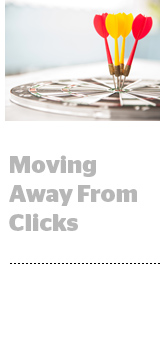
Ecommerce site Rue La La, which offers deals on designer fashion and goods, wants its members to have a great experience so they keep coming back.
“How do we stay top of mind for our best members and encourage them to come back over long periods of time?” said Jeff Steeves, VP of marketing at Rue La La.
As with many ecommerce players, one pillar of its retention strategy is retargeting. Rue La La buys media through Facebook, which performs well against the click-based metrics generally used to measure retargeting campaigns. But it found that those campaigns weren’t yielding incremental revenue growth.
“If you talk to a C-level executive at any ecommerce retailer leveraging retargeting, they care about growing revenue and profitability,” said Ric Calvillo, CEO at Nanigans, Rue La La’s programmatic partner of several years. “That’s been the question around retargeting forever: Is this really incremental, and would these visitors have converted anyway?”
Most ecommerce advertisers optimize their retargeting models toward clicks and views, assuming that because a user engaged with an ad, they’re more likely to convert. But neither of those metrics correlates to incremental revenue, Calvillo said.
“As long as you measure click-attributed return on ad spend, you’re going to confuse correlation with causation,” he said.
For example, if a repeat shopper watches Rue La La video ads and browses the site frequently, companies like Criteo and Google would spend more to retarget that person because they’re meeting their definition of engagement – clicking, viewing and browsing. But a regular Rue La La shopper knows what she wants, so showing her an ad probably won’t drive her to spend more.
“I don’t think people realize how broken the current optimization methodologies are,” Calvillo said.
To fix that discrepancy, Nanigans launched a tool in June that uses machine learning and predictive analytics to optimize bids for incremental sales lift.
Rue La La tried the new tool, which began running after a few weeks of ingesting data from Rue La La’s site and media buys. Incremental revenue grew six and a half times over a three-month period.
“Our prior efforts were more audience-focused,” Steeves said. “Nanigans brought the ability to identify which members we should be showing ads to, how frequently and with which message.”
Optimizing for incremental lift also helps clean up some of the retargeting issues that plague the industry, like that infamous already-purchased shoe that stalks its buyer around the web. If someone has already been targeted a few times, Nanigans’ incremental lift model will optimize a bid away from that user – even if they show classic signs of engagement, like clicking, browsing the site and watching videos.
“The number of impressions we’ve shown you matters a lot,” Calvillo said. “Pretty quickly the model will stop following you if you’re not showing signs of responding to the ad. If you’ve already bought the product, for instance, you shouldn’t see the ad anymore.”
For Rue La La, bombarding its members less with ads for things they’d already bought or seen improved the user experience, Steeves said.
“Optimizing a retargeting strategy is a huge opportunity for us and for most retailers,” he said.
Nanigans, which works with 120 advertisers, is running pilots for the incremental lift tool with about six other ecommerce sites.
This post was syndicated from Ad Exchanger.

More Stories
Inghams teams up with Together for groundbreaking media strategy
Exclusive: Academy CEO Expects Oscars Ratings to Defy Gravity Thanks to Streaming
Tokyo hosts first-ever OOH industry conference